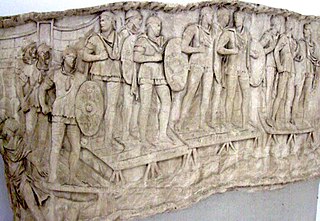A cohort was a standard tactical military unit of a Roman legion. Although the standard size changed with time and situation, it was generally composed of 480 soldiers. A cohort is considered to be the equivalent of a modern military battalion. The cohort replaced the maniple following the reforms attributed to Gaius Marius in 107 BC. Shortly after the military reforms of Marius, and until the middle of the third century AD, ten cohorts made up a legion. Cohorts were named "first cohort,” "second cohort," etc. The first cohort consisted of experienced legionaries, while the legionaries in the tenth cohort were less experienced.

The Auxilia were introduced as non-citizen troops attached to the citizen legions by Augustus after his reorganisation of the Imperial Roman army from 27 BC. By the 2nd century, the Auxilia contained the same number of infantry as the legions and, in addition, provided almost all of the Roman army's cavalry and more specialised troops. The auxilia thus represented three-fifths of Rome's regular land forces at that time. Like their legionary counterparts, auxiliary recruits were mostly volunteers, not conscripts.
Cohors prima Raetorum was a Roman auxiliary infantry regiment. It is named after the Raeti, a designation probably given to some Alpine tribes, which were part of the eponymous province Raetia et Vindelicum, later called simply Raetia. It comprised much of modern Switzerland, western Austria and Germany south of the river Danube. The Raeti originally spoke a non Indo-European language that seems related to Etruscan. However, by the time their territory was annexed by Rome under founder-emperor Augustus, they had become largely Celtic-speaking through contact with neighbouring peoples such as the Vindelici. Finally, during the centuries of Roman rule, they became Latin speakers: their distinctive provincial patois survives today in the form of the Rhaeto-Romance languages.
Cohors sexta Delmatarum equitata was a Roman auxiliary mixed infantry and cavalry regiment.

The Alpine regiments of the Roman army were those auxiliary units of the army that were originally raised in the Alpine provinces of the Roman Empire: Tres Alpes, Raetia and Noricum. All these regions were inhabited by predominantly Rhaetian peoples and Celtic-speaking tribes. They were annexed, or at least occupied, by the emperor Augustus' forces during the period 25–14 BC. The term "Alpine" is used geographically in this context and does not necessarily imply that the regiments in question were specialised in mountain warfare. However, in the Julio-Claudian period, when the regiments were still largely composed of Alpine recruits, it is likely that they were especially adept at mountain operations.

This article concerns the Roman auxiliary regiments of the Principate period originally recruited in the western Alpine regions of the empire. The cohortes Alpinorum came from Tres Alpes, the three small Roman provinces of the western Alps, Alpes Maritimae, Alpes Cottiae and Alpes Graiae. The cohortes Ligurum were originally raised from the Ligures people of Alpes Maritimae and Liguria regio of NW Italia.

The Imperial Roman army was the military land force of the Roman Empire from 27 BC to 476 AD, and the final incarnation in the long history of the Roman army. This period is sometimes split into the Principate and the Dominate (284–476) periods.
The Cohors XX Palmyrenorum was an auxiliary cohort of the Roman Imperial army. It was a cohors equitata milliaria, mixed infantry and cavalry regiment, originally recruited from the inhabitants of Palmyra in Roman Syria. There were also a small number (32–36) of dromedarii forces attached to the infantry.
Cohors PrimÆ Ælia Dacorvm was an infantry regiment of the Auxilia corps of the Imperial Roman army. It was first raised by the Roman emperor Hadrian in the Roman province of Dacia not later than AD 125 and its last surviving record dates c. 400. It was deployed, for virtually its entire history, in forts on Hadrian's Wall on the northern frontier of Britannia province.
By the size of the Roman army is meant the changes in the number of its contingents: legions, auxiliaries, Praetorian cohorts, Urban cohorts, vigiles, and naval forces over the course of twelve centuries – from 753 BC to AD 476.
Cohors [prima] Batavorum milliaria civium Romanorum pia fidelis was a Roman auxiliary cohort of infantry.
Cohors prima Ulpia Dacorum was an infantry regiment of the Auxilia corps of the Imperial Roman army. It was founded by the Roman emperor Trajan, probably in preparation for his planned war against Parthia (113-6). The regiment's honorific title Ulpia refers to the emperor's gens, or clan-name.

Cohors prima Flavia Canathenorum [sagittaria] [milliaria] was a Roman auxiliary cohort of infantry.
Aïn Schkor, Morocco is a hamlet in Morocco which served during the Roman Empire as one of five castra (forts) that guarded the city of Volubilis, located 3 kilometers to the south, from incursions from over the nearby Limes Africanus. In antiquity Aïn Schkor housed Spanish and Belgic cohorts.
The Cohors I Asturum et Callaecorum was a Roman auxiliary unit.
The Cohors II Asturum et Callaecorum [equitata] was a Roman auxiliary unit. It is known from military diplomats and brickwork.
Cohors tertia Ulpia Petraeorum [sagittaria] [milliaria] [equitata] was a Roman auxiliary cohort of infantry and cavalry.
Cohors prima Ulpia Galatarum was a Roman auxiliary cohort of infantry.
The Cohors II Lucensium [equitata] was a Roman auxiliary unit. It is attested by military diplomas and inscriptions.



